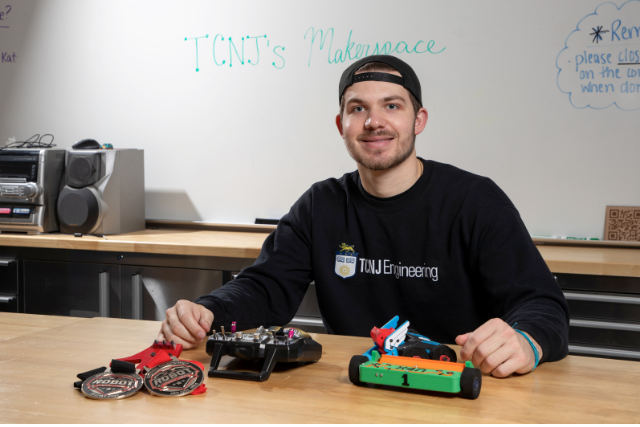
The first time Adam Cunard ’25 participated in a combat robotics competition with a few machines he’d cobbled together from Home Depot, he was randomly matched against himself. He enlisted his younger brother to help pilot and ended up losing to a robot of his own design.
“My brother technically won the first robot fight in the family,” laughs the technology and engineering education major.
A decade later, Cunard is a board member of the Garden State Combat Robotics League and has been ranked nationally for two years in a row. Now, he’s on a mission to bring robot combat into high school classrooms.
Combat robotics gained popularity through the British TV show Robot Wars, which features 250-pound robots with fearsome names like Behemoth and Sir Killalot trying to knock each other out of a ring.
“They’re remote-operated vehicles that basically have weapons of mass destruction attached to them,” says Cunard, who was hooked at an early age when his father, a technology educator, brought home a DVD of the show. A few years later, he came across a YouTube video showing “ant weight” robots that weigh in at under one pound, and was soon building his own ’bots and competing across New Jersey and Pennsylvania.
“It’s the perfect combination of a mental and physical challenge,” says Cunard, who still favors the ant-weight class.
His most successful bot, The Captain (named for Captain America), is a vertical spinner that launches opponents into the air with a 20,000 RPM rotating mass. At the same time, he’s been drawn to the activity’s tight-knit and collaborative community, which might see an eight-year-old kid best an MIT grad student or Lockheed Martin engineer, with no hard feelings on either side.
“There’s a popular saying in the community: the most likely person to help you fix your robot from the last fight is the person you’re fighting next,” he says.
He recently organized his own competition as part of the Trenton Computer Festival, hosted at TCNJ in March, and recently returned from battling his own ant-weight creations at the Robot Combat League National Championship in Santa Ana, California earlier this month.
After graduation, Cunard hopes to teach engineering to high school students. In addition to starting a combat robotics club wherever he ends up, he also aspires to establish combat robotics education nationally over the next five or 10 years.
“There is so much students can learn — materials science, manufacturing, design, electronics, interpersonal relationships, communication skills … ” he says. “I’m passionate about teaching them things that not only will they be able to use in the classroom, but also throughout their entire lives.”
— Michael Blanding
